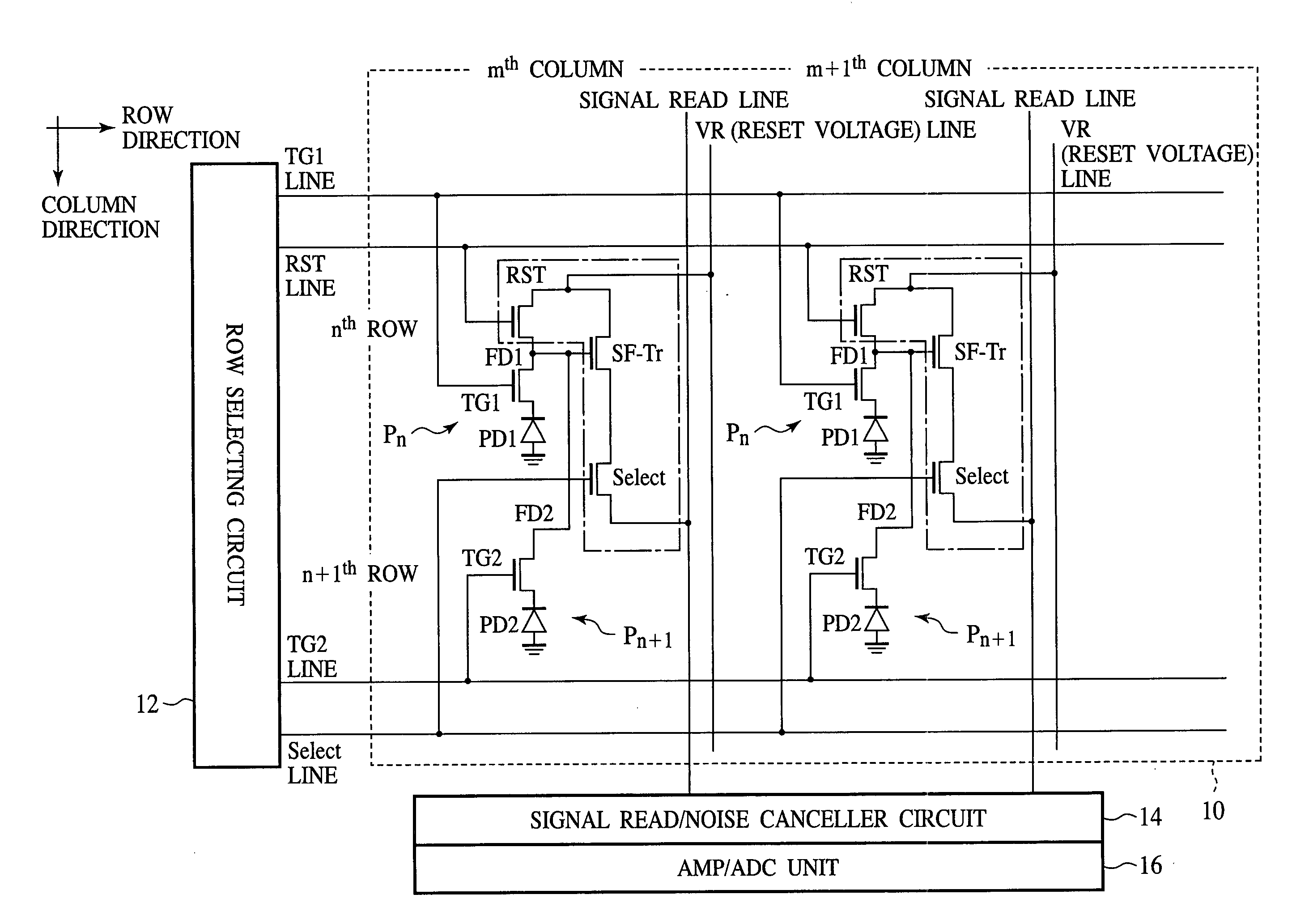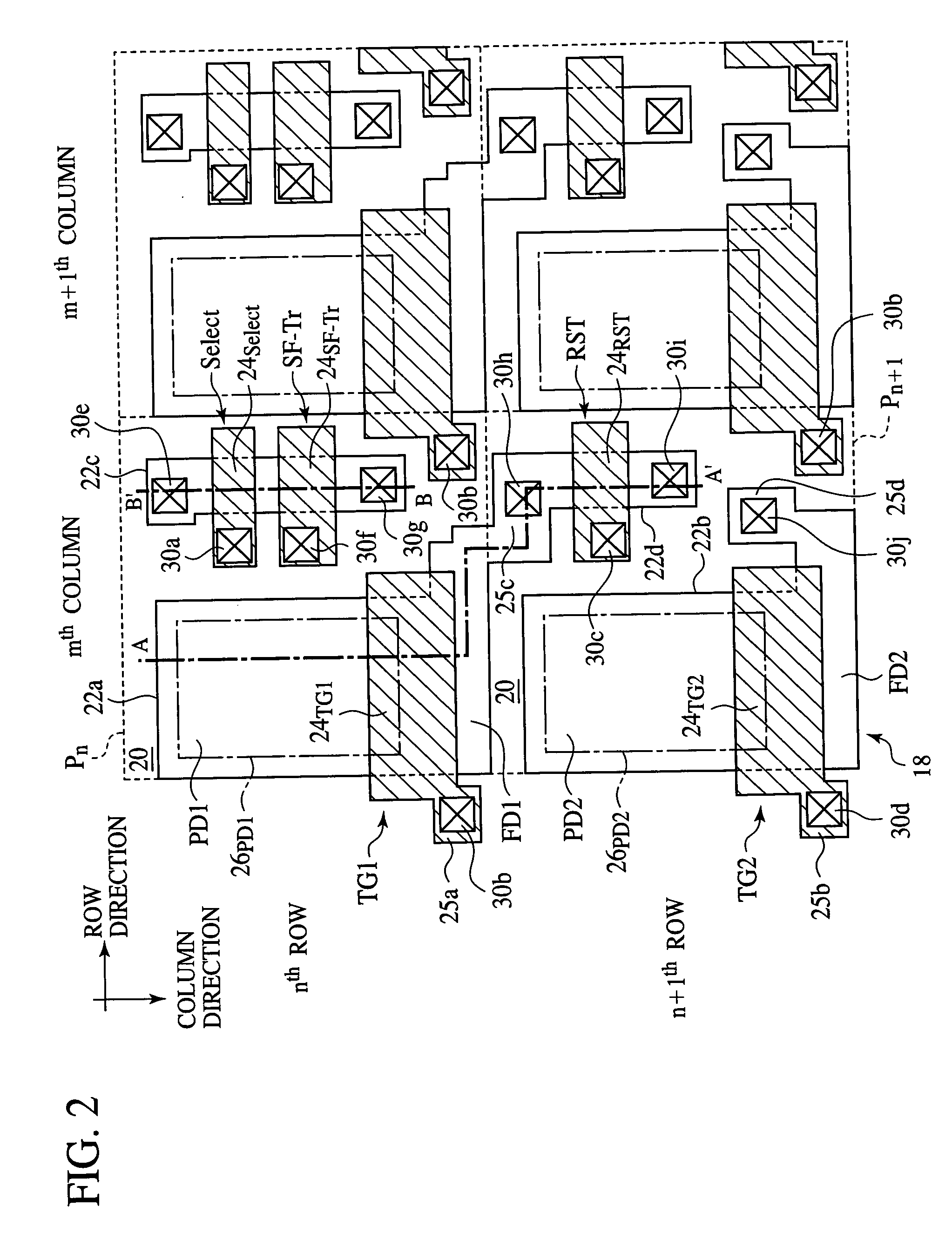Solid-state image sensor
a solid-state image sensor and image sensor technology, applied in the field can solve the problems of wide variations in photosensitivity and charge transfer characteristics, and the vulnerability of solid-state image sensors including 3-tr-pixels to noise caused by ktc noises
- Summary
- Abstract
- Description
- Claims
- Application Information
AI Technical Summary
Benefits of technology
Problems solved by technology
Method used
Image
Examples
first embodiment
A First Embodiment
[0054] The solid-state image sensor according to a first embodiment of the present invention will be explained with reference to FIGS. 1 to 10. FIG. 1 is a circuit diagram of the solid-state image sensor according to the present embodiment. FIGS. 2 to 5 are plan views of the solid-state image sensor according to the present embodiment, which show a structure thereof. FIGS. 6A-6B to 10 are sectional views of the solid-state image sensor according to the present embodiment in the steps of the method for fabricating the same, which show the method.
[0055] First, the structure of the solid-state image sensor according to the present embodiment will be explained with reference to FIGS. 1 to 5.
[0056] The solid-state image sensor according to the present embodiment is a solid-state image sensor including 4-Tr-pixels having elements made common between the pixels. That is, in the solid-state image sensor according to the present embodiment, a plurality of pixels each incl...
second embodiment
A Second Embodiment
[0168] The solid-state image sensor according to a second embodiment of the present invention will be explained with reference to FIGS. 11 to 16. FIGS. 11 to 13 are plan view of the solid-state image sensor according to the present embodiment, which show a structure thereof. FIGS. 14 to 16 are sectional view of the solid-state image sensor according to the present embodiment in the steps of the method for fabricating the same, which show the method. The same members of the present embodiment as those of the solid-state image sensor according to the first embodiment are represented by the same reference numbers not to repeat or to simplify their explanation.
[0169] The solid-state image sensor according to the present embodiment is the same in the circuit diagram, the basic structure and the fabrication method as the solid-state image sensor according to the first embodiment except that the first and the second metal interconnection layers 32, 26 are different from...
third embodiment
A Third Embodiment
[0206] Next, the solid-state image sensor according to a third embodiment of the present invention will be explained with reference to FIG. 18. FIG. 18 is a plan view of the solid-state image sensor according to the present embodiment, which shows a structure thereof. The same members of the present embodiment as those of the solid-state image sensor according to the first embodiment are represented by the same reference numbers not to repeat or to simplify their explanation.
[0207] The solid-state image sensor according to the present embodiment is the same in the circuit diagram, the basic structure and the fabrication method as the solid-state image sensor according to the first embodiment except that the plane shape of the gate electrodes 24TG1, 24TG2 of the transfer transistors TG1, TG2 are different. The structure of the solid-state image sensor according to the present embodiment will be explained with reference to FIG. 18. FIG. 18 is a plan view of the layo...
PUM
 Login to View More
Login to View More Abstract
Description
Claims
Application Information
 Login to View More
Login to View More - R&D
- Intellectual Property
- Life Sciences
- Materials
- Tech Scout
- Unparalleled Data Quality
- Higher Quality Content
- 60% Fewer Hallucinations
Browse by: Latest US Patents, China's latest patents, Technical Efficacy Thesaurus, Application Domain, Technology Topic, Popular Technical Reports.
© 2025 PatSnap. All rights reserved.Legal|Privacy policy|Modern Slavery Act Transparency Statement|Sitemap|About US| Contact US: help@patsnap.com



